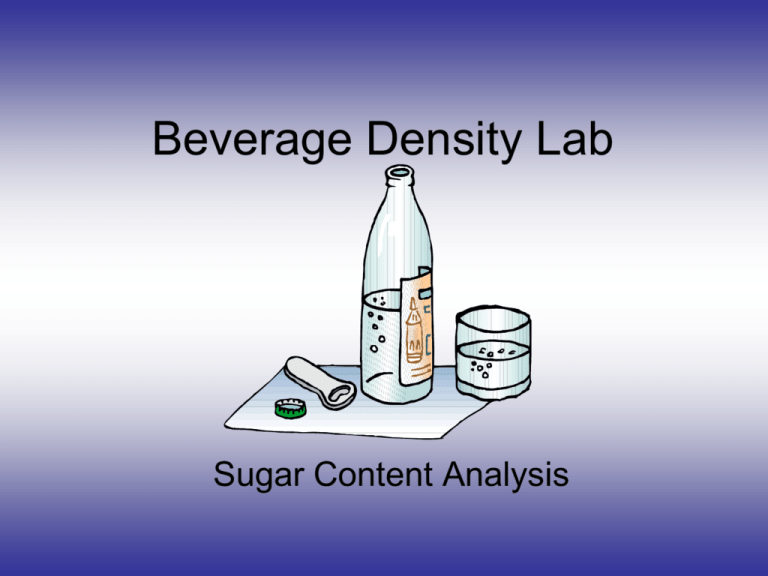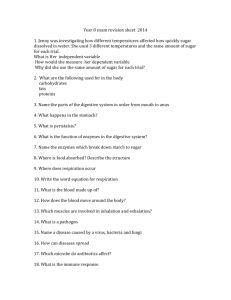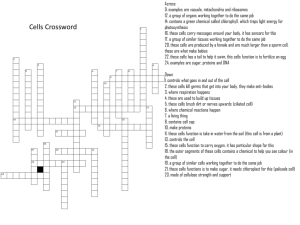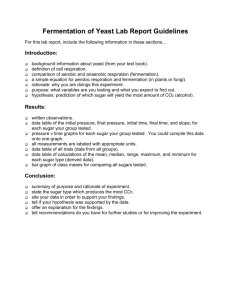
Beverage Density Lab
Sugar Content Analysis
Introduction
The density of a pure substance is a characteristic physical property that
can be used to identify the substance. Density is defined as the ratio of mass
per unit volume. It is an “intensive” property; that is, it does not depend on
the amount of the substance.
The density of any material is determined by measuring its mass and volume
and then dividing the mass by the volume. The mass of a substance can be
measured directly using a balance. The volume of a liquid can also be measured
directly using special laboratory glassware, such as a graduated cylinder, a buret,
or a pipet. In this experiment, liquid volumes will be measured using a pipet. A
pipet is designed to deliver an accurate and precise volume of liquid to another
container.
The density of a solution depends on its concentration, that is, how
much solute (solid) is dissolved in the solvent (liquid). The higher the
concentration of solute, the greater the density of the solution. A convenient way to express concentration is in units of weight percent, which
corresponds to the number of grams of solute that are present in 100 g
of solution. A 20% salt solution is prepared by dissolving 20 g of sodium
chloride in 80 g of water. (Notice that the final mass of the solution is 100
grams.) If the density of a solution is plotted on a graph against the
concentration of solute, a regular pattern is evident. Density is directly
proportional to concentration. A 20% salt solution, for example, has a
greater density than a 10% salt solution. If the densities of several
solutions on known concentrations are determined experimentally, a
calibration curve (graph) can be constructed that shows a straight-line
relationship between the density of a solution and the concentration
of solute. The calibration curve can then be used to find the concentration
of solute in an unknown solution.
Experiment Overview
The purpose of this experiment is to determine the percent sugar content
in beverages. The density of five sugar “reference” solutions will be measured
in Part A. The reference solutions contain known amounts of sugar (0-20%)
and have been dyed with food coloring to make it easier to tell them apart.
0% sugar
5% sugar
10% sugar
15% sugar
20% sugar
= clear
= yellow
= green
= blue
= purple
Their densities will be plotted on a graph to obtain a calibration curve of
density versus percent sugar concentration. In part B, the densities of two
beverages will also be determined and the calibration curve used to find
how much sugar they contain. The results will be compared against the
information provided on the nutrition labels for these beverages.
Pre-Lab Questions
1. If the following mass and volume data are used to calculate the density of
solution, how many significant figures are allowed in the calculated density?
Mass of solution = 12.53 g; volume of solution = 8.27 mL.
2. Calculate the density of the solution described in Question #1.
3. According to its nutritional label, orange soda contains 49 g of sugar per 355 mL
serving. If the density of the beverage is 1.043 g/mL, what is the percent sugar
concentration in orange soda?
Hint: This is a 2-step problem.
First, use the density to convert the 355 mL serving size to grams.
Then calculate percent sugar in the beverage.
Data Table A: Density of Reference Solutions
Solution
Mass, g
Sample Volume, mL
Density, g/mL
0% Sugar
9.95 g
10.00
0.995
5% Sugar
10.14 g
10.00
1.014
10% Sugar
10.34 g
10.00
1.034
15% Sugar
10.53 g
10.00
1.053
20% Sugar
10.73 g
10.00
1.073
Density vs. Percent Sucrose
Calibration Curve
1.08
1.07
Density (g/mL)
1.06
1.05
1.04
1.03
1.02
1.01
1.00
0.99
0
5
10
15
Percent Sucrose
20
25
30
Data Table B: Beverage Densities
Beverage
Mass, g
Sample Volume, mL
Density, g/mL
Powerade
10.27 g
10.00
1.027
Lemon-lime
soda
10.35 g
10.00
1.035
Cola
10.38 g
10.00
1.038
Apple juice
10.42 g
10.00
1.042
Grape juice
10.59 g
10.00
1.059
The relevant information
on this label is the grams
of sugars, NOT the Percent
Daily Value.
This soda contains 40 g of
sugar per 355 mL of beverage.
Nutrition Facts
Serving Size: 1 Can (355 mL)
Amounts Per Serving
Calories 150
Total Fat 0 g
Sodium 55 mg
Total Carb. 40 g
Sugars 40 g
Protein 0 g
% Daily Value*
0%
2%
13%
0%
* Percent Daily Values are bases on a 2,000
calorie diet.
from calibration curve
Data Table C: Results Table
Beverage
Measured
density, g/mL
Percent sugar
(experimental)
Amount of
sugar
(Nutrition label)
Percent sugar
(calculated from
Nutrition label)
Percent
error
Powerade
1.027
8.3%
15 g/240 mL
6.1%
*36%
Lemon-lime
soda
1.035
10.3%
38 g/355 mL
10%
3%
Cola
1.038
11.1%
42 g/355 mL
11%
1%
Apple juice
1.042
12.1%
38 g/296 mL
12%
1%
Grape juice
1.059
16.5%
40 g/240 mL
16%
3%
*Powerade contains a large amount of salt (electrolytes)
Pre-Lab Questions
1. If the following mass and volume data are used to calculate the density of
solution, how many significant figures are allowed in the calculated density?
Mass of solution = 12.53 g; volume of solution = 8.27 mL.
(3 sig. figs.)
(4 sig. figs.)
(3 sig. figs.)
2. Calculate the density of the solution described in Question #1.
Density =
mass
volume
Density =
12.53 g
8.27 mL
Density = 1.52 g/mL
3. According to its nutritional label, orange soda contains 49 g of sugar per 355 mL
serving. If the density of the beverage is 1.043 g/mL, what is the percent sugar
concentration in orange soda?
Hint: This is a 2-step problem.
First, use the density to convert the 355 mL serving size to grams.
Then calculate percent sugar in the beverage.
X g = 355 mL
1.043 g
= 370 g
1 mL
49 g x 100% = 13%
370 g
Data Table C: Results Table
Beverage
Measured
density, g/mL
Percent sugar
(experimental)
Amount of
sugar
(Nutrition label)
Percent sugar
(calculated from
Nutrition label)
Percent
error
Powerade
1.027
8.3%
15 g/240 mL
6.1%
*36%
Lemon-lime
soda
1.035
10.3%
38 g/355 mL
10%
3%
Cola
1.038
11.1%
42 g/355 mL
11%
1%
Apple juice
1.042
12.1%
38 g/296 mL
12%
1%
Grape juice
1.059
16.5%
40 g/240 mL
16%
3%
DO NOT use volume…
need to convert to mass first (using density)
X g = 355 mL
1.038 g
= 338 g
1 mL
42 g x 100% = 12%
355 mL
42 g x 100% = 11%
368 g
Printable
copy of
LAB
Teacher Notes
• Have students make standard reference samples of 5%,
10%, 15%, 20% sugar
• Use balances that have more than 0.0 g precision
• Students should use 10 mL pipets for references
• Teacher may want to set-up buret with beverage
samples
• Scales not working properly and pipet bulbs that don’t
work were largest problem with this lab.
• Have students place dirty pipets in bucket of soapy water
at end of lab
• DO NOT ALLOW students to pour samples back into
containers
Aspartame
Copyright © 2007 Pearson Benjamin Cummings. All rights reserved.



